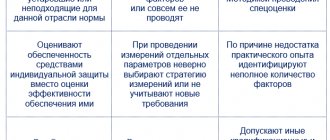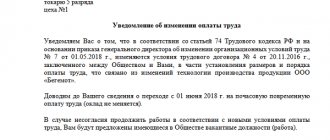Remuneration according to the Labor Code of the Russian Federation
They are determined in accordance with the profession, position, qualification category and qualification category of the employee. Additional payments, allowances and incentive payments due to the employee (for example, for long work experience in the specialty, high qualifications, deviations from normal working conditions) are indicated in the employment contract, or it makes reference to the relevant regulatory legal act or collective agreement providing the grounds and the terms of their payment. In this case, the employee must be familiarized with them against signature.
The criterion for determining wages is the quality of work, which characterizes its complexity, responsibility, tension, heaviness, and independence. The quality of work is manifested primarily in its complexity - the level of tasks performed by the employee.
Another criterion for determining the main part of wages is the conditions of the work performed, which are also important for the second - compensatory - part of wages, since tariff rates and salaries are relatively rarely set taking into account working conditions.
A component of wages are incentive payments (additional payments and bonuses of an incentive nature, bonuses and other incentive payments).
It should also be noted that the minimum wage (minimum wage) does not include compensation, incentives and social payments, that is, it consists exclusively of the main (tariff) part. It follows that the tariff rate, salary (official salary) of an employee cannot be lower than the minimum wage provided for by law
As stated in Article 131 of the Labor Code of the Russian Federation, wages are paid in cash in the currency of the Russian Federation (in rubles). In accordance with a collective agreement or an employment contract, upon a written application from an employee, remuneration may be made in other forms that do not contradict the legislation of the Russian Federation and international treaties of the Russian Federation. The share of wages paid in non-monetary form cannot exceed 20% of the accrued monthly wage. Payment of wages in bonds, coupons, in the form of promissory notes, receipts, as well as in the form of alcoholic beverages, narcotic, poisonous, harmful and other toxic substances, weapons, ammunition and other items in respect of which prohibitions or restrictions on their free circulation are established , not allowed.
Article 132 of the Labor Code prohibits any kind of discrimination when establishing and changing wage conditions.
Employer's liability
Article 142 of the Labor Code stipulates that the employer and (or) the employer’s representatives authorized by him in the prescribed manner, who have delayed the payment of wages to employees and other violations of wages, are liable in accordance with the Labor Code and other federal laws. The Criminal Code establishes liability for non-payment of wages for more than 2 months.
In case of delay in payment of wages for a period of more than 15 days, the employee has the right, by notifying the employer in writing, to suspend work for the entire period until payment of the delayed amount (Part 2 of Article 142 of the Labor Code).
An employee who was absent from the workplace during his working hours during the period of suspension of work is obliged to return to work no later than the next working day after receiving written notification from the employer of his readiness to pay the delayed wages on the day the employee returns to work.
Civil and labor legislation provides for material and disciplinary liability. If the actions (inaction) of an official contain elements of a crime, then he can be brought to criminal liability, and if these actions (inaction) are in the nature of an administrative offense, then it is possible to bring the guilty person to administrative responsibility.
Second commentary to Article 144 of the Labor Code
1. The title of the article and its content have been changed. In the previous version, the article provided for the right of all employers to establish various systems of bonuses, incentive payments and allowances, taking into account the opinion of the representative body of employees. It also established the procedure and conditions for the use of incentives and compensation payments in organizations financed from the federal budget.
In the new edition, this article provides for the procedure for establishing both payment systems and labor incentives, but only for employees of state and municipal institutions. The procedure for establishing tariff payment systems and stimulating the work of employees of state and municipal institutions is also discussed in Art. 143, according to which these systems are installed for employees of federal state institutions by the Government of the Russian Federation, state institutions of the constituent entities of the Russian Federation - by state authorities of the constituent entities of the Russian Federation, and municipal institutions - by local governments.
Article 144 provides that systems of payment and labor incentives (including tariff systems of payment and labor incentives) are established by collective agreements, agreements, local regulations in accordance with laws (federal and constituent entities of the Russian Federation) and other regulatory legal acts. It seems that the content of these two articles is not consistent and does not answer the question of what is established by the Government of the Russian Federation, the state authority of a constituent entity of the Russian Federation, a local government body, and what is established by collective agreements, agreements, and local regulations.
2. This article establishes a number of guarantees for employees of state and municipal institutions. These include state guarantees for wages that are general for all employees, enshrined in the Labor Code of the Russian Federation, and additional ones: the wages of these employees cannot be lower than the basic salaries, rates of the corresponding qualification groups established by the Government of the Russian Federation. This means that the Government must establish a certain minimum rate (salary), mandatory for both constituent entities of the Russian Federation and local governments. Since the law prohibits setting rates (salaries) below this amount, at the appropriate level it can either coincide with that established by the Government of the Russian Federation or exceed it.
3. For the first time, a new concept of “professional qualification groups” is being introduced into legal regulation. However, the legislator indicates only the most general features of this concept and delegates to the federal executive body, which carries out the functions of developing state policy and legal regulation in the sphere of labor, to establish criteria for classifying the professions of workers and positions of employees to the corresponding professional qualification groups.
The procedure for paying wages to employees
According to Art. 136 of the Labor Code, a worker receives payment based on the results of his work at least twice a month. Payment is calculated after the work is completed. The maximum period for transferring funds is 15 days from the end of the period for which it is calculated.
Each time when transferring payment to a working employer, the established Art. 136 TC payment procedure:
- The amount of earnings is calculated.
Salary according to art. 129 of the Labor Code of the Russian Federation is a combination of several types of payments, among which there is always remuneration for work, so the calculation comes down to calculating salary or income at the tariff rate. If necessary, the calculation includes adding the amounts of incentives and compensation due to the employee for the time worked.
Employees are notified in writing of income and the amounts on which it is calculated, i.e.
- about the size of the salary parts;
- the amount of other payments;
- on the grounds and amount of deductions.
In organizations where payments to workers are made in cash through the accounting department or cash desk of the company, notification is made using a payroll, which is signed by a familiar employee. If an employer uses the services of a credit institution to pay employees, then, as a rule, workers are notified by sending information to the employee’s phone, posting information about accruals in their personal account on the bank’s website, or in another way.
The salary is transferred to the employee “hand to hand” in cash or transferred to an account with a credit institution.
Forms and systems of remuneration
Forms and systems of remuneration are established in Chapters 20, 21 of the Labor Code.
Article 131 of the Labor Code provides for the possibility of paying wages in two forms:
The monetary form is the main one, since it is money that represents the universal equivalent. The natural form can only be used partially (no more than 20%) and must be provided for by a collective agreement; it cannot be established by internal local acts (orders). In addition, a written statement from the employee is required, indicating his consent to receive part of the salary in kind. Paying wages in alcoholic beverages, as well as in goods whose circulation is limited by law, is unacceptable (Article 129 of the Civil Code).
Depending on economic indicators, the measurement of wages is divided into time-based, piece-rate and piece-rate.
- piecework wages depend on quantitative and qualitative indicators of labor;
- time-based - depending on the time spent and qualifications of the employee;
- The lump sum wage system is established not for a specific production operation, but for the entire volume (cycle) of work, i.e. payment is made for completing a chord task.
Currently, there is a tendency to improve the system of payment and incentives for workers, used in the practice of companies in combination with additional payments and bonuses for the personal contribution of the employee, which leads to an increase in the company’s income.
Additional forms of remuneration include contract and commission forms.
- contract involves payment for work stipulated by the terms of the contract;
- commission payment is based on the commission agreement, which regulates the relationship between the commission agent and the principal.
Basic remuneration systems
Remuneration as a concept is a collective image of rewarding a person for the work performed. This includes direct wages, additional allowances, compensation, benefits and bonuses. Sometimes it happens that it is expressed not only in monetary terms, but also in material and non-material incentives. For example, vacation vouchers, various kinds of certificates and even food products. But most often this is a certain amount depending on the quality of the work performed or the production rate. The employer himself establishes the method of rewarding employees, but any of them must respect the rights of the working person. Moreover, the government sets the minimum wage (minimum wage).
Depending on the industry, working conditions, and specifics of the work process, there are different payment systems that are established according to the type of work. The main goal is to motivate employees to meet work targets and ensure a smooth work process.
Thus, there are various types of incentives that can be applied to employees. Modern remuneration systems include tariff, non-tariff and mixed types of remuneration.
Tariff system
The tariff system is the most common option. From the name it follows that initially a certain fixed amount (tariff) is set. It can be either fixed (regardless of the amount of work and time) or proportional to the selected parameter.
You can choose a progressive tariff, which increases with the volume of work performed or the qualifications and position of employees. This method is called a graded wage system. It involves combining a number of positions according to their importance for the company. Within it, positions are also arranged in a hierarchy. For example, cleaning and garbage removal positions are somewhat less significant than accounting staff. And the position of chief accountant assumes more responsibility and knowledge than that of an ordinary accountant in a narrow area.
Thanks to the grading method, staff motivation and responsibility for completing assigned tasks increases, since upon promotion or transition to a higher grade, wages and other incentives increase.
Tariff-free system
Employees are not set a specific amount and no time period is specified for receiving it. The main task is to perform a large amount of work. In this case, the person receives a percentage of the company's profits.
IMPORTANT! According to the Labor Code, workers must have a fixed income not less than the established minimum wage. Thus, even with piecework payment, the minimum amount is paid if the month is worked in full.
Mixed system
In a mixed system, an employee is given an average or minimum income, but it can vary depending on work results. If good performance is achieved, it increases; in case of failure, a minimum amount is paid, up to one minimum wage.
Procedure for payment of wages
Salary payments can be made in two main ways:
- By paying cash from the company's cash desk. Salaries are paid according to the location of the company. If it is paid elsewhere, it must be specified in the employment contract.
- By transferring funds to the employee’s bank card. This can be a card linked to a salary account, or any other employee debit card. An employee has the right to change the bank to receive his salary at any time. To do this, he needs to write a written statement to the employer at least 5 working days before receiving wages.
In the near future, it is planned to completely transfer salary payments to non-cash form.
The place where payments in kind are made must be fixed in a collective or employment agreement.
Typically, wages are divided into an advance payment and a final payment (it is the second payment that represents the final payment of wages). The amount of the advance is determined in any order. This can be a fixed amount (for example, 5,000 rubles) or an advance tied to the salary (for example, 50% of the salary). In this case, the advance is paid in full without reducing personal income tax, and the final payment is transferred minus the advance and personal income tax.
On paydays established by the enterprise, maternity benefits, temporary disability benefits and child benefits are also paid. Whereas vacation pay is paid three days before the start of the vacation.
Thus, the employer’s responsibilities include not only the fact of issuing wages, but also compliance with payment deadlines. Salaries must be paid at least 2 times a month, maintaining intervals between payments of at least 15 days. The final payment is made no later than the 15th day of the month following the settlement month. The specific timing of payment of wages is determined by the employer at its discretion. He must fix them in an employment or collective agreement or in another legal act. Salaries can be paid in cash from the company’s cash desk or in non-cash form on a card.
Dear readers, each case is individual. If you want to find out how to solve your particular problem, call:
- Moscow.
- Saint Petersburg.
Salary reduction
Calculating the amount of earnings involves deducting various deductions from the worker’s income. A number of them do not depend on the efficiency and integrity of the employee. So, the employer in any case withholds the following amounts:
- personal income tax (Chapter 23 of the Tax Code);
- insurance contributions for social, medical and pension insurance (Article 425 of the Tax Code of the Russian Federation, Law “On Mandatory Social Insurance...” dated July 24, 1998 No. 125-FZ).
A number of deductions are made by court decision and do not relate to the employee’s work activity. For example, these are the amounts:
- alimony (section 5 of the RF IC);
- deductions from the earnings of those sentenced to correctional and forced labor (Article 50, Article 53.1 of the Criminal Code of the Russian Federation).
Salaries may be reduced by deductions related to the employee’s work activities, for example:
- deprivation of a mandatory bonus or reduction in its size if the conditions for such actions are provided by the employer (letter of Rostrud dated December 18, 2014 No. 3251-6-1);
- deduction of amounts previously transferred to the employee due to a counting error (Article 137 of the Labor Code);
- repayment of unspent advance payment for a business trip that has not been returned to workers (Article 137 of the Labor Code);
- compensation for material damage caused to the employer (Article 238 of the Labor Code);
- return of amounts from the employee’s previously paid wages if the employee’s guilt in idle time, failure to comply with labor standards (Article 137 of the Labor Code), etc. is proven.
Let's summarize. Salary is a guaranteed income for an employee, automatically accrued within the framework of labor relations for fulfilling labor standards and varying due to the worker’s qualifications, length of service, complexity of work or other grounds established in the Labor Code or by the employer. According to the Labor Code of the Russian Federation, wages consist of additional payments and remuneration for labor. The salary amount may be reduced by deductions. In accordance with Art. 136 of the Labor Code, remuneration is made from 2 times a month in 3 stages, including calculation of earnings, notification of the employee about it and, in fact, payments.
Commentary on Article 271 of the Labor Code of the Russian Federation
For all workers under the age of 18 who, in accordance with Article 92 of the Labor Code, have reduced working hours and, in accordance with Article 270 of the Labor Code, have reduced production standards, payment is established in proportion to the time worked or in proportion to production (depending on the remuneration system) .
In proportion to the time worked, wages to employees under the age of 18 are paid on a time-based basis, which is typical for part-time work, and not for short-time work, which, in accordance with Article 92 of the Labor Code, is established for this category of workers. That is, for workers aged 15 to 16 years, the tariff rate (official salary) will not exceed 60% of the tariff rate (official salary) of an adult worker, and for workers aged 16 to 18 years - 90%.
In case of piecework payment, the labor of minor workers is paid at the piecework rates established for adult workers. Due to the fact that their working hours are shorter, their piecework earnings will also be less than that of an adult worker.
Students working in their free time from school are also paid in proportion to the time worked or production. Here we are talking about both students of general education institutions and students of educational institutions of vocational education - primary, secondary or higher. They are subject to the same payment rules as other workers under 18 years of age.
The employer, at his own expense, can establish additional payments for employees under 18 years of age that increase the level of remuneration for minor workers to the level of remuneration for workers of the corresponding categories for the full duration of daily work with time-based payment, with a piece-rate wage system - up to the tariff rate for time, by which the daily work hours of young workers are reduced.
In the case where these additional payments are provided for by a collective agreement, the costs of their payment, on the basis of paragraph 25 of Article 255 of the Tax Code of the Russian Federation, are taken into account in the organization’s expenses when calculating income tax.
Article 144 of the Labor Code of the Russian Federation. Remuneration systems for employees of state and municipal institutions
1. Article 144 of the Labor Code of the Russian Federation is devoted to remuneration systems for employees of state and municipal institutions.
Employees of state and municipal institutions should be distinguished from state civil servants who serve in state bodies, and from municipal employees who serve in municipal bodies. The conditions for remuneration of state civil and municipal employees are determined by special laws: the Law on the State Civil Service (Articles 50, 51) and the Law on the Municipal Service.
2. Parts 1 and 2 of Article 144 of the Labor Code of the Russian Federation clarify the procedure for establishing remuneration systems for employees of institutions financed from various budgets. When establishing remuneration systems for them, general rules apply - securing such systems in collective agreements, agreements, local regulations, taking into account the general guarantees provided for by labor legislation and other regulatory legal acts, conducting tariffs based on the Unified Tariff and Qualification Directory of Work and Professions of Workers , Unified qualification directory of positions of managers, specialists and employees.
Along with the general rules, special requirements are established for this category of workers. Remuneration systems for employees of institutions must be established in accordance with laws and regulations that determine the conditions for remuneration of their labor and are adopted at the appropriate level. When developing them, the unified recommendations of the Russian Tripartite Commission (see commentary to Article 135) and the opinions of the relevant trade unions (trade union associations) and employers' associations are taken into account.
It should be noted that employer associations in the public sector have not been created until recently.
3. When applying Article 144 of the Labor Code of the Russian Federation, it should be taken into account that an additional guarantee has been established for employees of institutions - basic salaries (basic official salaries) and basic wage rates for each professional qualification group. The salary of each employee assigned to a certain professional qualification group cannot be lower than the established basic values. When establishing basic salaries, the differences between professional qualification groups will be taken into account and reasonable relationships will be established between the wages of individual groups of professions, taking into account the complexity of work and other factors.
Basic salaries will be established by the Government of the Russian Federation, and the list of professional qualification groups and criteria for classifying blue-collar professions and office positions into professional qualification groups will be established by the federal executive body exercising the functions of developing state policy and legal regulation in the field of labor (Ministry of Health and Social Development of Russia).
4. The specifics of establishing remuneration systems for employees of institutions predetermine the nature of the content of the collective agreement, agreement, or local regulatory act. Public sector institutions (and employee representatives), when adopting these sources of labor law, are more bound by the requirements of regulatory legal acts than employers in the real sector of the economy. In particular, they must comply with the standards establishing the wages of workers and employees of the relevant professional qualification groups. This will inevitably lead to the formalization of both the content and the process of concluding collective agreements and agreements in the public sector.
Labor Code of the Labor Code of the Russian Federation Chapter 21. WAGES
Appeal ruling dated November 11, 2014 in case No. 33-14653/2014). This danger arises if the employment contract states that the bonus is part of the salary and a specific amount and frequency of bonuses are established (for example, monthly).
Therefore, it is better to indicate in the employment contract only a reference to the LNA on bonuses. If the terms of the bonus are formulated accordingly and payment is not guaranteed, then the court will uphold the non-payment (see, for example, the Appeal decision dated 05/07/2015 in case No. 33-3789/2015, the Appeal decision dated 07/08/2014 in case No. 33-27385).
For example, in an employment contract, the conditions for bonuses can be formulated as follows:
The following wording can be used in the Bonus Regulations:
For some categories of workers, the law establishes mandatory salary supplements. Thus, northern bonuses are paid on the basis of Art. 315 TC, Art. 11 of the Law of the Russian Federation of February 19, 1993 No. 4520-1, and allowances for “harmful persons” - on the basis of Art. 147 Labor Code of the Russian Federation.
The allowances established by law (northern allowances, allowances for employees working in hazardous working conditions) must also be provided for both in the LNA and in the employment contract, which is confirmed by judicial practice (see the Appeal ruling dated February 24, 2014 in case No. 33-1457 , Appeal ruling dated December 18, 2013 in case No. 33-8030/2013).
For example, in an employment contract you can indicate the following: “A percentage increase of 50% of wages for work in an area equated to the regions of the Far North is applied to the actual accrued wages, including bonuses related to the performance of labor duties.”
print version
Forms of remuneration
According to the provisions of Art. 135 of the Labor Code, wages to employees are calculated on the terms of the employment contract concluded with them, taking into account the current remuneration system. Each employer develops its own remuneration system for its employees, focusing on its preferences and economic working conditions. At the same time, the adopted remuneration system cannot contradict the provisions of the Labor Code. Such provisions are automatically invalid and cannot be applied in practice.
There are two key types of forms of remuneration: time-based and piece-rate. The time-based form is used in enterprises when it is impossible to normalize production or there is no need for it. In this case, it makes more sense to pay employees for the time they work, rather than for the amount of work they do.
In this way, salaries are most often calculated for administrative personnel, lawyers and marketers, secretaries, etc.
The time period that underlies the calculations can be a day, a month (the most common type of payment is monthly salary) or another option. If an employee works part-time, then his salary is accrued only for the period worked.
Also, organizations often practice the use of a time-based bonus form, when a bonus for quality work done is added to the basic salary on a time-based basis. Bonuses can be paid on a regular basis or in a lump sum.
The piecework form of payment is usually applied to employees of production departments or specialists involved in the service sector. It is more profitable for the employer to pay them not for the time worked, but for the amount of work completed. For each unit of product produced or volume of services provided, the employee is charged a certain amount (also called the piece rate).
It turns out that the higher the productivity, the higher the salary the employee will receive. Therefore, this form of payment acts as an incentive to increase productivity for employees.
In small start-up organizations, a non-tariff form of payment may be used, in which employee earnings may depend on the financial performance of the company. In practice, tariff and non-tariff forms of salary calculation can be combined: for example, when an employee regularly receives a certain salary, and the other part of the amount (bonuses) is accrued to him based on sales results or the company’s financial results for the quarter.
Let us repeat: what should be the ideal remuneration system?
- Commensurate to the work. Choose a system based on the characteristics of your business: pay either for time, if the result does not really depend on effort, or according to KPI or piecework.
- Motivating. Give bonuses, add bonuses for meeting KPIs and pay for overtime.
- Transparent. Try to make sure that the salary amount is not an unpleasant surprise for employees.
- Automated. Simplify your processes so you don't have to spend a lot of time on them every month.
- Open to criticism. Collect and listen to feedback to make timely changes.
The better the remuneration system in your business is built, the more opportunities for growth there will be. You will no longer be distracted by solving ordinary problems and disputes, and your employees will work, knowing for sure that they will receive a decent reward.
Organization of remuneration at the enterprise
The organization of remuneration at an enterprise is a series of activities aimed at remunerating employees in direct accordance with the quality and quantity of work performed.
When organizing a system at an enterprise in accordance with which workers will be paid, it is necessary to take into account the need to use:
- tariff regulation of wages (tariff system of remuneration);
- development of the form and system by which the employee will be paid;
- determination of the system for the formation of official salaries;
- the need for bonuses;
- validity of indicators used in the bonus system.
The basis of labor rationing is the balance of labor costs that are necessary to produce any unit of goods or services under certain technical conditions. The main task in labor standardization is to develop and implement progressive standards at the enterprise.
The organization of remuneration is associated with solving a dual problem:
- give each employee guarantees that his work will be paid in relation to the results of his work and in accordance with the cost of labor in the labor market;
- ensure the employer makes a profit during the production process and compensates for costs.
Collect and listen to feedback
This is the most important thing - not to adhere to the rules that were once established, but to change them in accordance with the environment. After all, anything can happen - KPIs will change, employees will work more, prices in stores will increase everywhere. And the previous salary will no longer suit people.
To find out in time that something needs to be changed, periodically ask employees whether they are satisfied with the remuneration system. This is possible not in person, but through anonymous feedback forms: for example, in Google Forms. It will be easier for employees to talk about real problems without revealing their identity, and you will receive objective assessments.
Don’t forget to collect feedback from department heads as well. They may not be comfortable preparing multiple reports or calculating salaries using different formulas. Your task is to make everyone feel comfortable, then both managers and ordinary employees will do the most useful thing for the company.









